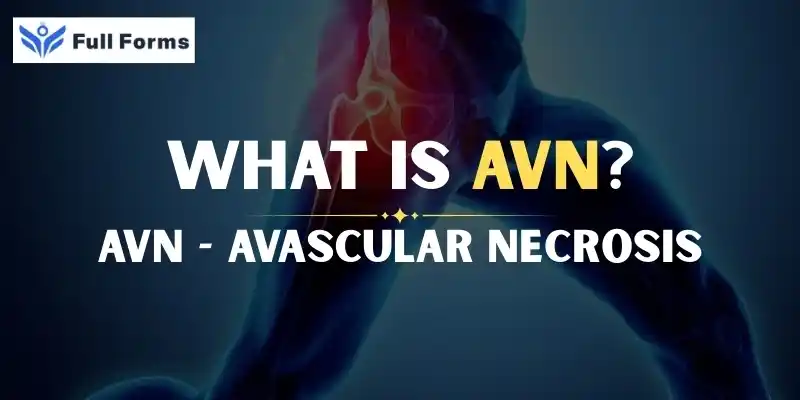Avascular Necrosis
(AVN)

Description
Avascular Necrosis (AVN): Plain Explanation of a Complicated Illness
Bones, just like our skin and muscles, are living tissues in the body. For them to be strong and healthy, they need blood to flow pretty well. What if that blood supply stopped? That is what is known as Avascular Necrosis, or simply AVN.
Here’s the simple thing about this condition.
Avascular Necrosis: What the Heck Is That?
In avascular necrosis (AVN or osteonecrosis), we have a condition in which a portion of the bone is said to die due to the lack of enough blood flowing through it. As we stipulated earlier, bone tissue starts deteriorating until it crumbles since there is no blood nourishing it. This could eventually cause the bone to crumble and be immensely painful and damaging to the joint.
AVN: How it Happens
A disruption in the blood supply to a bone causes AVN to occur. Here’s how it may occur:
- Trauma
Fracture or joint dislocation that injures blood vessels around the bone, hindered blood flow to the bone. - Prolonged Steroid Use
Long-term users on high doses of corticosteroids like prednisone are more susceptible. The steroids could change how the body metabolizes fat, which might then occlude blood vessels. - Alcoholism
High intake of alcohol produces fatty substances in the blood that can impede capillaries and thereby reduce blood flow to the bones. - Medical Conditions
Various conditions can increase the risk of AVN. Such conditions include:
Sickle cell disorder
Systemic Lupus Erythematosus
AIDS/HIV
Coagulation disorders of blood
Sometimes the exact cause of AVN is not known. In such circumstances, it is referred to as idiopathic AVN.
Avascular Necrosis Symptoms
There may be no symptoms at all in the early stages of AVN and only as the disease progresses do more bones become affected. Typical signs and symptoms include:
- Joint pain which gets worse, especially when the joint is put under weight
- Progressive increase in pain over time
- Joint stiffness and mechanical restriction in the range of motion
- Range of motion is limited
- Limping especially in the presence of hip AVN
As the bone dims there is generally mild pain that progresses to a dull ache.
How Is AVN Diagnosed?
Physicians will usually perform a physical examination, take a medical history, and specifically consider steroid use or traumas. They’ll confirm AVN by means of:
- X-rays: These will typically evidence bone damage and are most effective in the latter stages.
- MRI: AVN can be detected at an early stage by MRI before it is appreciable on X-rays.
- CT scan: Sometimes, a CT scan may be recommended to get a clearer picture of the bone.
- Bone scan: This helps to identify particularly avascular portions of the bone.
Treatment for AVN
The bone that is affected and the extent to which the disease has spread will influence the decision taken. Pain relief, prevention of further bone loss, and preservation of joint function are the objectives.
1. Non-Operative Management for Early AVN:
- Anti-inflammatory and analgesic drugs
- Anticoagulants (if there’s a tendency to form clots)
- Active physical therapy for functional retention of the joint
- Crutches or canes should be used to avoid weight-bearing on the affected bone
- Life style changes, e.g. abstinence from alcohol or steroids
However, non-surgical therapies may slow the progression of the disease rather than eradicating it completely.
2. Medical Intervention
Surgical intervention may be necessary once the bone has collapsed. Common procedures include:
- Core Decompression: A small drill hole is made in the bone to reduce pressure and help make room for new blood vessels.
- Bone Graft: Transplantation of healthy bone tissue to replace the area with damaged tissue.
- Osteotomy: Reshapes the bone so that there is less strain on the site of injury
- Arthroplasty: Where a severely damaged bone is replaced with an artificial joint-most commonly in hips and knees
Couple living with AVN
Early diagnosis and treatment can attain effective management of AVN. Most individuals with mild AVN can live normal lives quite regularly with the right care and monitoring. In more severe cases, joint replacement may be the most appropriate way to relieve pain and restore motion.
One of those lifesaving factors is:
- Do not drink excessively.
- Do not smoke.
- Be active, but do not engage in high-impact activities.
- See your doctor on a regular basis.
Don’t let yourself or your loved ones wait when warning signs of AVN appear. With the right diagnosis and treatment plan, you can stay in motion, free of pain and protect your joints.
